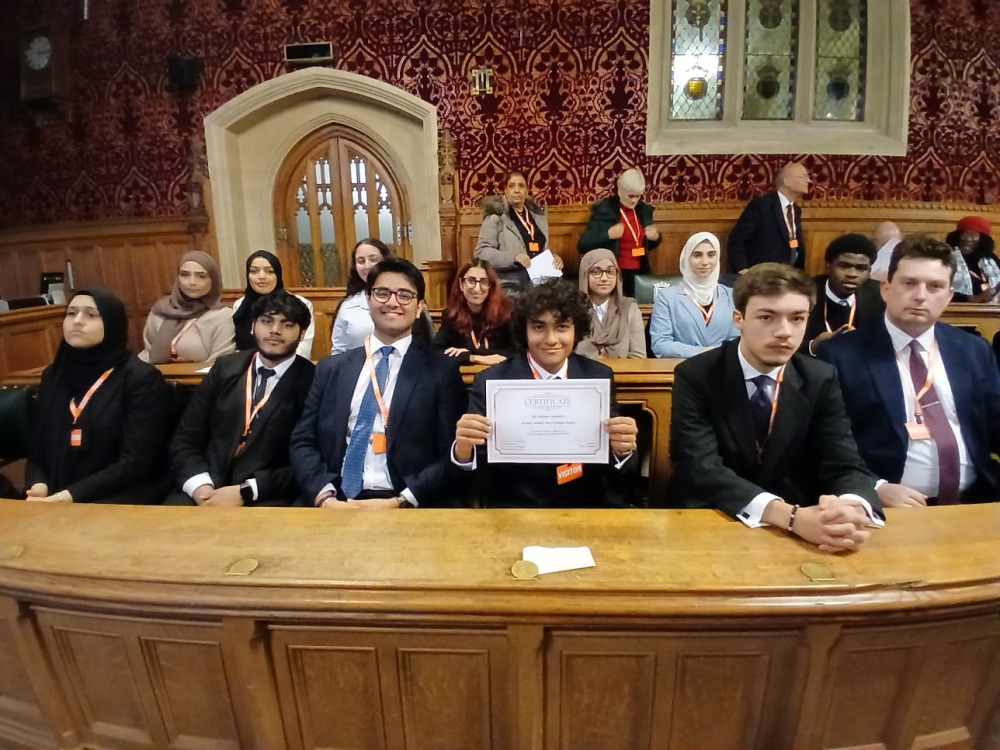
On October 14th 2024, the ‘KFOR and Kosovo +25’ exhibition was presented at the House of Commons. Mr Martin Vickers, MP, Chair of the Kosovo and Albania All Party Parliamentary Group, pictured above, opened the event, as one of the sponsoring MP’s, and welcomed the invited guests. MP’s Mr Angus MacDonald and Mr Richard Foord also sponsored the event.

Mr Vickers was followed by Sitakumari, Heartstone’s Director, giving a brief introduction to ‘KFOR and Kosovo +25’, how and why Heartstone had received the invitation to embed Nick Sidle, photographer/writer, with the earliest UK regiments of KFOR for 1 year from 2000-1 and the start of the project to restore the original images in time for the 25th anniversary of KFOR in Kosovo. She then introduced each of the speakers.

The Speakers

Lord George Robertson, Secretary General of NATO at the time of the photodocumentary said:
‘It is a great delight to be here tonight and thank you for that generous introduction. Remembering 25 years is a remarkable phenomenon for many of us and I am seeing regimental ties around the room and some of my key collaborators from the time are also here. It seems like yesterday. We have something like 300 new MP’s in Parliament. For some of them, this feels like ancient history. I met a couple of them a few weeks ago and asked if they were new Labour MP’s. They said yes, without a flicker of recognition. I said, ‘I was Defence Secretary in 1999 and you were quite young then.’ One of them was five and the other was twelve! So I think this project is all the more important for reminding people of how an intervention took place and what it meant to the people of the country. Everywhere, there is a diaspora and the memories are very vivid. A few months ago, I did address a street gathering in Pristina on an anniversary day and I got a rapturous reception for it. I think it brought home to me deeply and emotionally what we felt at the time. At the time, we felt we had to do it, We put a lot of troops in then. Thousands of troops will have been in the Balkans during that period and experienced a lot of trauma. It was an episode of our lives that will stay with us for a long time.
And as to the nation of Kosovo, it is one of the newest nations in Europe. I met someone in a café the other day who said, ‘My shoes are older than my country…’ and I think that says how new the country actually is, making its way in the world with all our hopes and aspirations.
So these photographs, which I have seen now several times including at the National Museum of Kosovo in Pristina, bring back the humanity of the intervention, of soldiers who were there and whose memories of that time will be vivid, and of the people of Kosovo who experienced the troops who came in and liberated them. This is a wonderful exhibition, which should remind us all of the way in which an intervention can work and leave behind a nation and people deeply grateful for what happened at that time.’

He was followed by Lord David Hannay, Chair of the UN All Party Parliamentary Group at the House Commons, who said:
‘Peacekeeping tends to be one of the overlooked aspects of the modern military role. It shouldn’t be but it is. Why is that so? It suggests that when there is a large international operation that goes really well, think of Namibia, Cambodia, Mozambique, El Salvador or Cyprus, it is quickly forgotten. When we think of those that go less well – think Bosnia, Lebanon or even Kosovo – much of the blame tends to get attached to the peacekeepers themselves even when it is really due to the ethnic roots of militias or foreign powers which prevent the peacekeepers, often by violence, from carrying out their mandate. That’s why the present occasion marking this exhibition on Kosovo in 2000 is so valuable. They contradict those caricatures.
My own involvement with peacekeeping was mainly in Cyprus for seven years when I was working with the UN and the EU, unsuccessfully alas, to find a legal solution to the island’s division. People would come to me claiming it would be better to withdraw the UN peacekeepers. Then the chaos and violence which would ensue would hasten a political solution. I didn’t buy that. It’s not the business of the international community to tolerate violence and human rights abuses. Just look at what’s going on now in the Palestinian occupied territories of the West Bank of Jordan to see some of the consequences of that sort of vacuum. So the NATO peacekeepers in Kosovo and the British contingents are appropriately recognised in this exhibition, but also others such as the Royal Hussars in which my son served in Kosovo at the time and many others, for what they have done and continue to do as an exemplary job. They deserve all the support and thanks we can give them and this occasion is one way of doing that. I am greatly honoured to have as our speaker Lord Robertson, who has just spoken to us about why this was really a pretty important moment in British, NATO and European foreign policy. He played a constructive hugely positive role as Defence Secretary and then Secretary General of NATO in establishing Kosovo as an independent state and ending the breaches of the international humanitarian law which was so prolific. Now, as Chair of the new Government’s Strategic Defence Review, I thnk we can be confident he will regard peacekeeping as an integral part of Britain’s security policy, particularly in the west Balkans where all is far from being resettled in a peaceful and sensible way.
Now I cannot conclude without saying a word of congratulations to Sitakumari. By sending these photo exhibitions and showing them at the Tower of London, Edinburgh, Pristina and now in this Parliament, she has done something of real value. The photographs of Nick Sidle show graphically and far more compellingly than just words, what things were like in Kosovo in 2000 and what the UK contingent of KFOR, both individually and collectively said and did to make the situation better for Kosovars. That is the real contribution to international peace and security and we should recognise it as such.’

General Sir Nick Carter spoke of his role in Kosovo at the time, with the Royal Green Jackets, one of the regiments featured in the photodocumentary, giving the audience a real insight into what was happening at the time. He said:
‘It’s a great privilege to be here this evening and to be able to say a few words about our expeience in Kosovo. We, the Royal Green Jackets, were the first battalion to go into Pristina at the end of the intervention. Sitting on the right of me here is General Patrick Sanders, one of my company commanders who subsequently became head of the Army. It was a very interesting time for all sorts of reasons and I am going to tell you two stories just to bring things to life compared to the tactical level presented by Lord Robertson and Lord Hannay.
One of the times I remember most is New Year’s Eve. You will remember this was the millennium and there was going to be a great celebration at the O2 and of course New Year in Kosovo was going to happen an hour before that. I remember patrolling up to the centre of Pristina, where everyone was going to assemble to celebrate the new year, and I was called up onto the stage by the Kosovan who was becoming the Mayor at the time and some of the UN representatives and the clock struck midnight. At that point, many of the 40,000 or so Albanians seated around the stage or standing, raised their AK47’s into the air and fired them off with tracer and I remember thinking, this was exciting as they chanted ‘NATO, NATO, NATO’. I thought, we really had achieved something here. I remember patrolling back to my headquarters and switched on the television to see what was happening at the O2 and then thinking, gosh, we are in the right place here!
The second story I want to tell you happened in February 2000, in Mitrovica, which is still a bit of a problem in Kosovo. It went up in flames. The French who were there, were finding it very difficult to control and as a result, a lot of reinforcements were drafted in to try and settle this down and stop the rioting. My battalion ended up on a bridge called Austerlitz bridge. Our task was to prevent some 15,000 Serbs coming across to the south over the bridge. At the same time, some 50,000 Albanians were marching all the way up to Mitrovica. By this time, temperatures were down to about 15 degrees. I had some 300 soldiers on the bridge and there we were, like meat in a sandwich. I don’t think anyone thought the Albanians would make it to Mitrovica, but of course they are a very determined people and sure enough, we had an extraordinary afternoon where we essentially had to try and keep two sides apart. At the end of the day, we talked the whole thing down. It made the headlines. It was an important moment as Mitrovica stands out as one of the problems Kosovo has had to wrestle with over the course of the last 25 years as well. I was often seen because I spent much of my time on top of a Warrior that afernoon trying to talk the crowd down. Much like Lord Robertson’s story, I was with a Kosovo Albanian barber the other day who looked at me and said ‘I know you’. He was one of the Albanians who had marched that day to the bridge in Mitrovica.
Putting all that aside, this exhibition is important because we live in very turbulent times and what Kosovo reminds us is that when the international community comes together, as it did at that point, it is possible for us to achieve something, and we need the international community to come together now to wrestle with some of the very difficult problems we have in geopolitical terms. I very much hope this will happen. Let’s celebrate through these photographs what a tremendous achievement it was then.’

HE Mr Ilir Kapiti, Kosovo Ambassador to the UK
Mr Kapiti was present at the Tower of London staging in January of ‘KFOR and Kosovo +25’ and then at the National Memorial Arboretum staging in June. At the House of Commons he spoke once again of the importance and relevance of this exhibition, particularly given the continued presence of KFOR in Kosovo. His speech also acknowledged the role of the National Museum of Kosovo, unable to be at the event, but who had provided a speech to be read by Sitakumari. Mr Kapiti is pictured below with Ms Elena Noel, a longstanding member of Heartstone’s Advisory Council.

The National Museum of Kosovo had staged the exhibition in Pristina in June 2024 and gave the following speech:
‘On behalf of the National Museum of Kosovo, we want to express our deepest regret for not being able to join you in person tonight at this significant event at the The House of Commons. Although we can’t be there with you, please know that our hearts are with you. We are truly honored that the “KFOR and Kosovo +25” exhibition centred on the photographs of Nick Sidle is being showcased in such a prestigious setting.
We would like to extend our heartfelt thanks to Martin Vickers MP, Lord George Robertson, Lord David Hannay, Gen Sir Nick Carter and everyone who has contributed to making this event a success. Your support means so much to us. It’s through collaborations like this that the stories of resilience, courage, and unity can reach new audiences.
When the “KFOR and Kosovo +25” exhibition was first presented in Kosovo, Lord Robertson’s contribution deeply resonated with the public. The impact of his words and actions was so profound that we decided to extend the exhibition to three times its original duration. His dedication and what he has done for Kosovo have left an indelible mark on our people and his statement about the power of the photographs and what they express has to be taken seriously
When Heartstone visited the National Museum of Kosovo, we took the opportunity to ask for their assistance in tracing and honoring the soldiers who tragically lost their lives during and after the KFOR mission. Our aim is to collect their stories, create lasting tributes, and ensure they are remembered not only within the museum but also in public spaces. This tribute will honor both the soldiers and their families, ensuring their bravery is recognized for generations to come
This is a mission we’re deeply committed to pursuing, and we believe that with the ongoing collaboration of international partners like Heartstone, and what can be achieved from the event today, we can ensure these stories are properly preserved and given the respect they deserve.
This exhibition holds a special place in our hearts. It reflects Kosovo’s journey and the invaluable role of KFOR in helping rebuild our nation after a dark period in our history. We hope this exhibition continues to inspire and remind us all of the power of international cooperation and peace-building as well as the resilience of ordinary people even in the most difficult of circumstances to find a humanity and way to live their lives.
Although we can’t be with you today, we’re eager to continue this important work and look forward to further collaboration, building on the strong relationships we’ve established.
Thank you all once again for your presence and for keeping the spirit of this exhibition alive.
Vjollca Aliu, Deputy Director and Alban Bakija, Custos’
The Kosovan soldiers and soldiers from the Images

Special guests in the audience included two Kosovan soldiers, children at the time of the photodocumentary who were able to give a powerful personal insight into several of the images presented at the event. The soldiers had been introduced by Fort George in Inverness, Highland Scotland, where they have been working on a joint project. One of them had been present at the Highland staging of the exhibition. They are pictured here holding up one of the large format images from the exhibition depicting a soldier taking the hand of a little girl, who runs up to him in an alleyway with graffiti and bullet holes. This captured ‘moment’, totally unplanned, has become one of the signature images of the whole photodocumentary. In November, Ian Young, the soldier in the image, was located with the assistance of Carol Valentine, mother of Cpl Simon Valentine, described further below. He has since been interviewed for the exhibition and his statement will be added to the next staging. Carol was at the event together with Paul Davies, pictured at left (in photo below in blue shirt), also one of the soldiers from the images.Both have now been part of several stagings of the exhibition. The large format photo being held up is another signature image from the exhibition from a patrol visit to a Roma village.


The Photographs
Around 120 images from the ‘KFOR and Kosovo +25’ photodocumentary out of approximately 200, which will form the final exhibition, have now been restored and reworked. These were presented at the event through photo books and on screen.
Cpl Simon Valentine, in both photobook images on the right, helped to arrange, with extraordinary efficiency, an aid drop for the returned refugee family he is pictured with in the bottom image. Bearing in mind his age at the time of the image is 19, this was representative of his remarkable maturity, personal concern and desire to see something practical done, which he was able to see through to a successful conclusion. 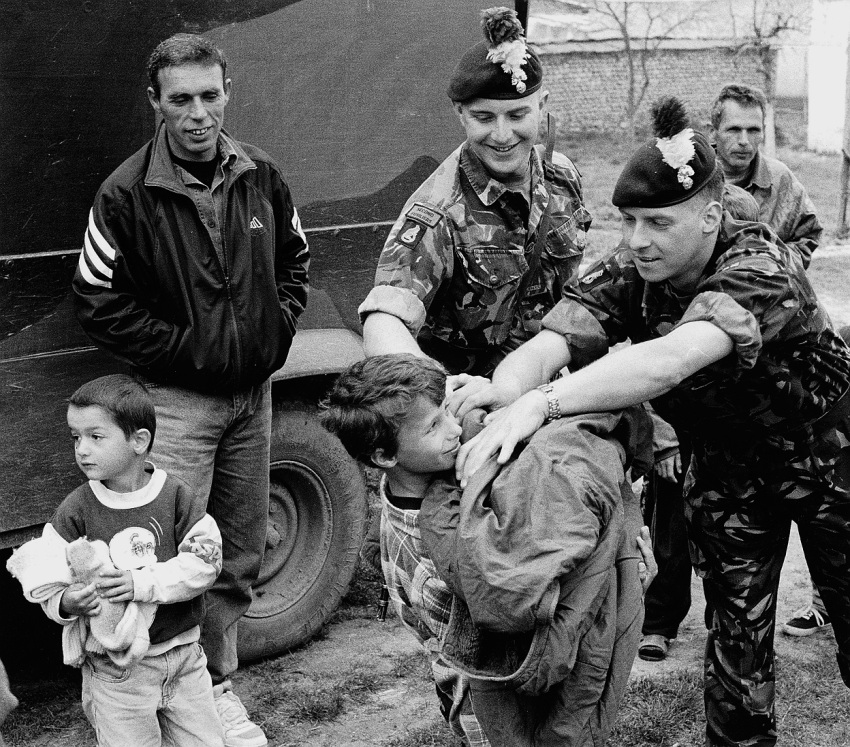
Paul Davies is pictured on the left handing out the blankets and toys to the same family the next morning.
Paul spoke to guests at the event as did Carol, representing her son, Simon, who was tragically killed in Afghanistan a few years later. Both Paul and Carol together with the Kosovan soldiers brought the story vividly to life with their reflections 25 years later.

Another double page from the photobook presentation demonstrated how peacekeepers made contact with civilians with the aim of building a positive relationship from which a sense of security can follow. The lower image shows an elderly Serb man, marooned in his apartment for fear of retaliation, sitting with one of the KFOR soldiers, who is asking about what he needs which he can assist with. Between them is a piece of furniture, acknowledged by both Serb and Albanian citizens as culturally important and in this instance, exemplifying the sense of feeling safe.

Special guests
Other special guests at the event included Sir Gerald Howarth, above left, who has helped bring sponsors for the new exhibition, and High Sheriff of Staffordshire Julia Mitchell, MA, Oxon, who is now working on a programme of exhibition stagings across her county and the surrounding areas, ensuring a wide reach across the middle of England.
Third from left in photo above is Nila Joshi, together with Jerry Piper, at right, both Heartstone CISC Co-Directors, who together with Sitakumari helped to run the House of Commons event.

The National Memorial Arboretum, who hosted an exhibition of ‘KFOR and Kosovo +25’ in June, were also present at this event and continue to support the programme.
From Wales, Hannah Searle, Assistant Curator at the Firing Line Museum located in Cardiff Castle, host to the 1QDG section of the exhibition, was present together with the Museum’s Deputy Chairman. The exhibition, funded by Heritage Lottery Fund Wales, has been moved on to the VC Gallery in Newport and S Wales schools will be starting Story Circle projects in January bringing a wider reach in 2025.

High Sheriff of Greater London, Millicent Grant KC (Hon) pictured on right with Nila Joshi, left, is now assisting with extending stagings and projects across Greater London beyond the seven boroughs currently participating.

From right to left: Col (retd) Simon Diggins, OBE, Chair of Trustees – The Fusiliers Museum, Sitakumari, Ms Nuala Riddell-Morales – Director, Carnaval del Pueblo, Ms Emma Rowland – Mayor of London Office.
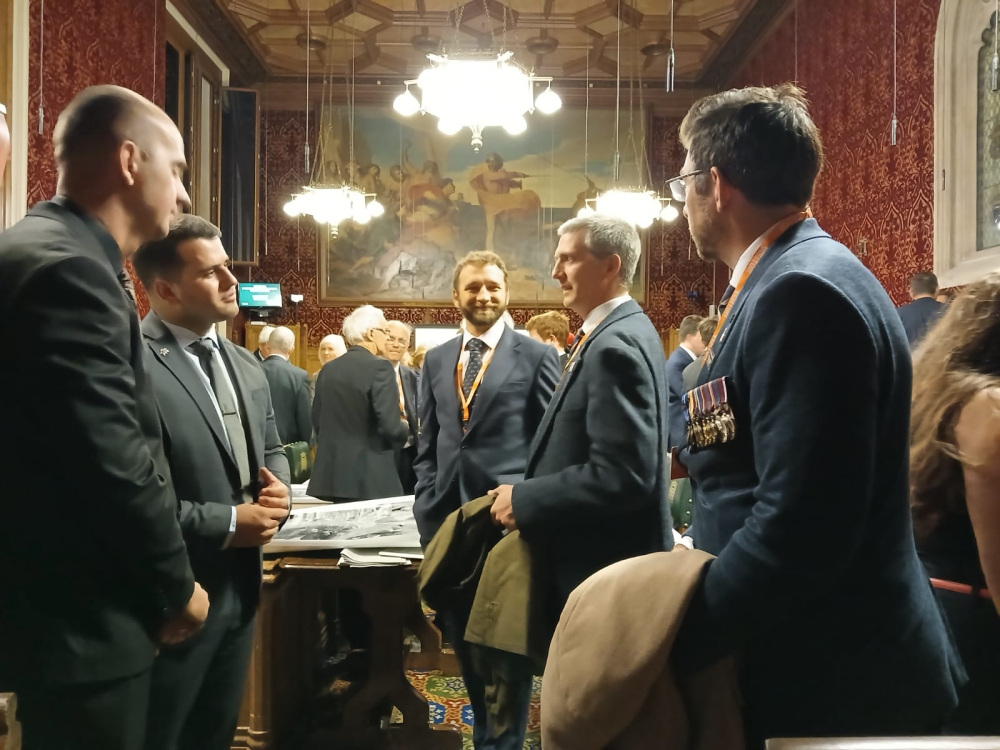
Sponsors present included representatives of Thales, BAE Systems Ltd, Babcock International, Supacat, Aspire Defence Ltd, GE Aerospace. Here, some of the sponsors meet the Kosovan soldiers. Lord Michael Hintze, the first sponsor who helped to get the project off the ground, was not able to be at the event but was acknowledged for his initial support from which the rest followed.

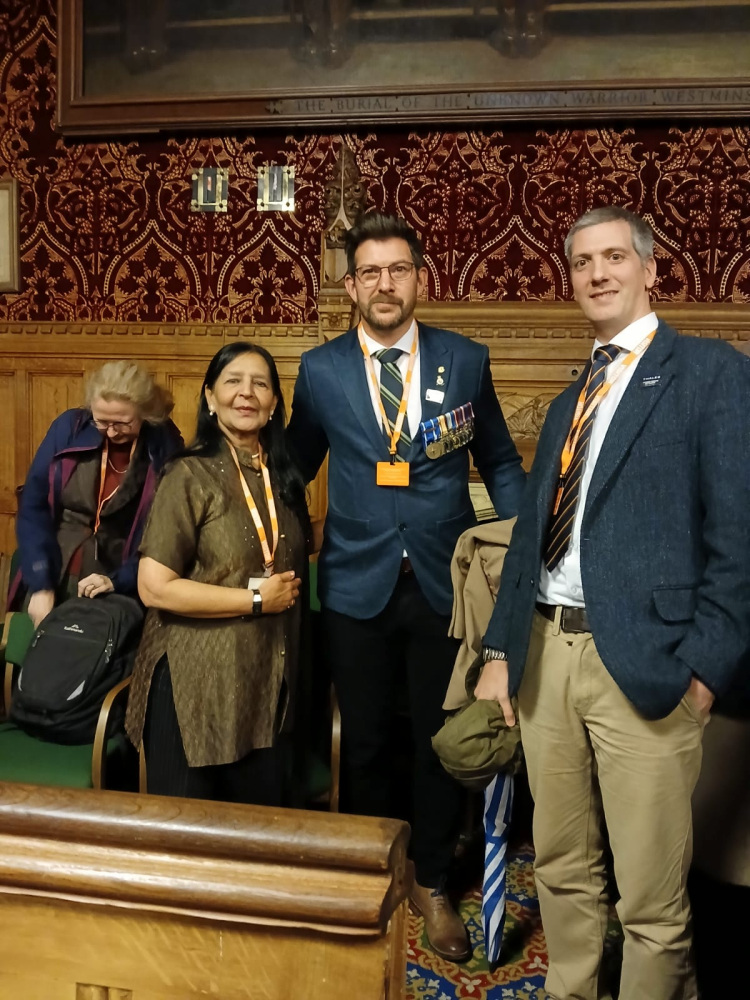

Outreach to Young People

Reaching the next generation with our stories is a very important part of what Heartstone does. All major events include invited young people from areas where projects are running – Story Circles for the younger age group 9-12, installation projects for older age groups 15+. This event was an opportunity for invited young people from Croydon and Westminster, where Heartstone projects using the ‘KFOR and Kosovo +25’ photodocumentary alongside ‘The Heartstone Odyssey’ book are active, to meet with all those present who are contributing to the story and gain a greater understanding of the background from their perspective. This is a valuable exercise as it enables the young people to interact with and question those who are part of a story they are using, thus bringing them into closer contact with the issues behind the story and people who have made a difference.

The students left and right are from Croydon, another of the participating London boroughs. They are all part of Heartstone Story Circles (see below) in the borough, their work has been exemplary providing the inspiration for many new areas to follow. Here is what some of them said about their experience and being part of the Heartstone project in Croydon:
The students pictured on the left and below have taken charge of the Westminster ‘KFOR and Kosovo +25’ exhibition installation. They are staging small-scale events in their own respective boroughs over the next few months and have already won commendation for what they have done to inspire others in their borough.
Here is what some of them said about the House of Commons event:
‘Experiencing the KFOR +25 Kosovo exhibition for Heartstone Chandra at the House of Commons was such an exciting and meaningful moment for me. Being in the heart of the UK’s political scene made it even more special—the history and influence of the location really added to the experience. Getting to talk to policymakers in such an important setting made the stories of KFOR’s 25 years in Kosovo and the resilience of its people feel even more impactful. It was amazing to see how the exhibition, in such a famous place, helped bring people together and spark conversations about peace and understanding.
Ayaan Langeh
Habi Ebeid speaks below of the experience of touring the exhibition installation in Westminster:
‘Hosting and touring the KFOR event gave me a lot of insight. It gave me knowledge on Post-Cold War international relations and how NATO played a pivotal role in its peacekeeping operation to prevent hateful genocide, and history from repeating itself. I was honoured to play a role in touring it, making speeches about it, and talking with educated people who know far better than me on the insights and complexions of such an event. From LSE professors, to politicians, the whole event was insightful, sound, and memorable. It was especially important and special for our Kosovo and Albanian community, who make up a large number of this our school community and collective culture, and it was great to be a part of this experience with them.’
Habi Ebeid
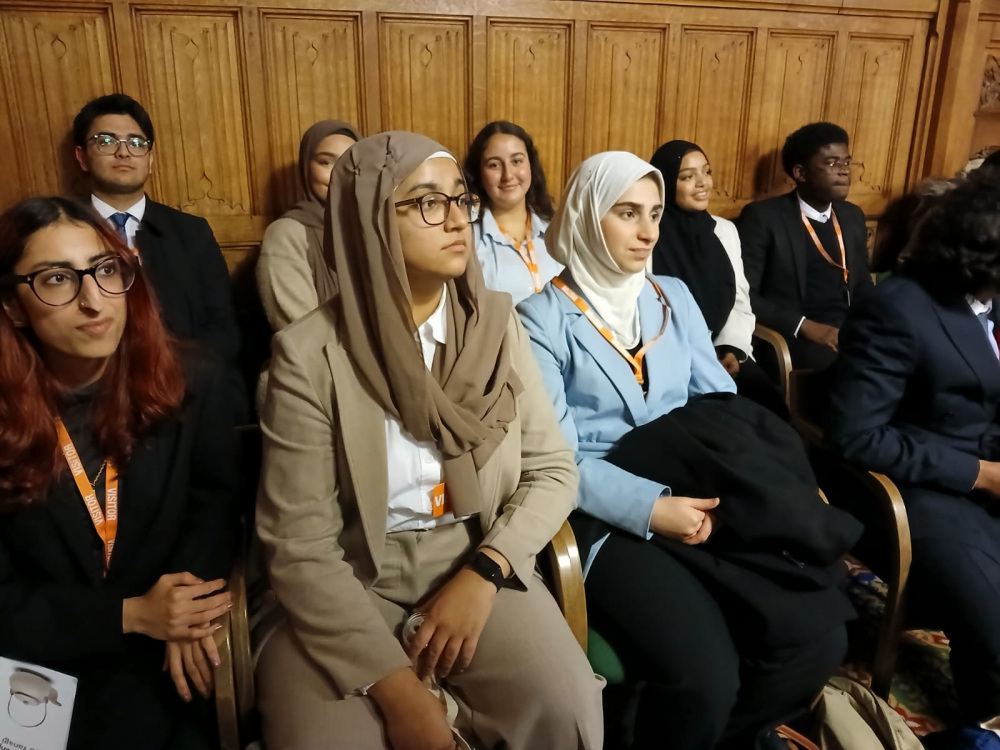
Heartstone Story Circle certificate ceremony

Earlier in the day, the same chamber had been filled with children and teachers from Story Circle groups across London. Story Circles are typically class or out-of-school groups reaching 9-12 year olds. Each receives a set of Heartstone stories, including the ‘KFOR and Kosovo +25’ Story Module, a set of images from the photodocumentary which can be used in these settings to generate discussion/debate, bring different groups together and challenge prejudice/intolerance. Each Story Circle produces their own exhibition as an outcome which provides an opportunity to reach out to surrounding community. This ensures each Heartstone photodocumentary reaches a significant grass-roots popultation cutting across all communities, cultures and faiths. Children and young people had been selected to attend the House of Commons event.

Our grateful thanks to our sponsoring MP’s Mr Martn Vickers, Mr Angus MacDonald and Mr Richard Foord, speakers – Lord George Robertson, Lord David Hannay, Gen Sir Nick Carter, HE Mr Ilir Kapiti , Sir Gerald Howarth and sponsors – Lord Michael Hintze, Thales, BAE Systems, Babcock International, Supacat, Aspire Defence Ltd and GE Aerospace.


